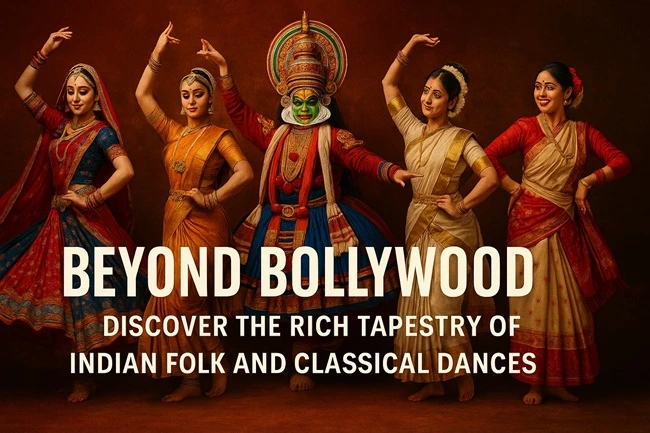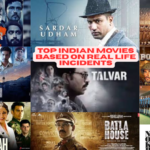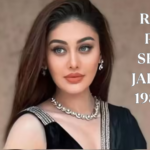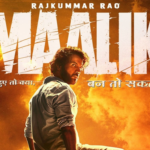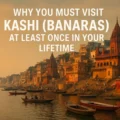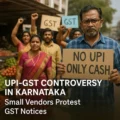Have you ever watched a dance performance that made your heart beat in sync with the rhythm, even if you didn’t understand the language or region?
That, right there, is the magic of India’s folk dances. They don’t ask for translation. They speak a universal language the language of emotion, tradition, and community.
India, with its countless dialects, communities, and climates, is not just a country, it’s a continent of cultures. And if you really want to feel the pulse of these cultures, skip the five star hotel itineraries for once. Visit a local fair, attend a village festival, or just stand by a roadside procession. You’ll witness movements that aren’t just performances, they are stories told through rhythm.
Let’s take a vibrant journey through some of the most iconic and unsung Indian folk and classical dances. And by the end of this read, don’t be surprised if you feel like swaying to one of these beats yourself!
Best Indian Folk and Classical Dances Are :
1. Bihu – Assam’s Joy in Motion
Let’s begin from the East Assam. Bihu isn’t just a dance, it’s the celebration of life itself.
Performed during the Rongali Bihu festival in April, this high energy dance brings together young men and women dressed in beautiful Mekhela Chador (traditional Assamese attire) adorned with red and white motifs. The movements are quick, rhythmic, and filled with playful gestures often mirroring the energy of spring, harvest, and love.
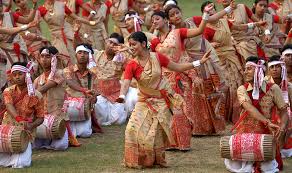
Ever watched a group of dancers move like flowing water while the sound of dhol and pepa fills the air? That’s Bihu for you.
Why You Should Experience It:
If you’re in Assam during April, don’t just sit and watch locals might just pull you in for a step or two. And you won’t forget the feeling for life.
2. Ghoomar – Grace of Rajasthan
When the desert land of Rajasthan decides to dance, it does so with unmatched elegance.
Ghoomar, primarily performed by the women of the Bhil tribe and later adopted by Rajput royalty, is a swirl of grace. Picture women in vibrant ghagras with mirror work and veils, spinning in synchrony creating a kaleidoscope of color and rhythm.
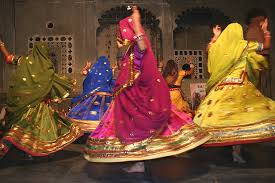
Did you know the word “Ghoomar” comes from “ghoomna” which literally means twirling? That’s what the dance celebrates the beauty in every spin.
Cultural Insight:
Ghoomar isn’t just about beauty it symbolizes womanhood, devotion, and royal heritage.
3. Garba – Gujarat’s Soulful Circle
No talk of Indian folk dances is complete without Garba.
Performed during the nine nights of Navratri, Garba is not just a dance, it’s a spiritual offering. Participants dance in circles around an earthen pot (garbo) symbolizing Goddess Durga. The footwork is rhythmic, the claps are synchronized, and the energy is electric.
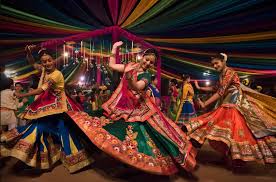
Each night of Navratri in Gujarat draws thousands dressed in colorful chaniya cholis and kediyas dancing away till the break of dawn. Imagine being a part of a moving galaxy.
Why Garba Is Addictive:
It brings together spirituality, celebration, and community in one unforgettable package.
4. Bhangra & Gidda – Punjab’s Power-Packed Performances
Punjab doesn’t believe in subtlety when it comes to celebrating.
Bhangra, originally a harvest dance by men, is all about explosive energy. Jumping, kicking, bending, and leaping every movement is a celebration of life’s highs.
Gidda, its female counterpart, is more lyrical filled with traditional boliyan (folk couplets), humor, and expressive gestures.
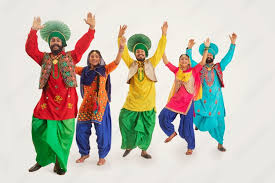
Feel like you’ve lost your zest? Just 5 minutes of Bhangra will recharge your soul no gym needed.
Cultural Takeaway:
These dances go beyond performance. They’re expressions of resilience, celebration, and Punjabi pride.
5. Lavani – Maharashtra’s Bold & Beautiful
With powerful beats of the dholki and swift, sensuous movements, Lavani has always pushed boundaries.
Performed by women in nine yard sarees (nauvari), Lavani combines storytelling, socio political commentary, and powerful expression. It’s fast paced, bold, and demands attention.
Ever seen expressions that narrate entire love stories, heartbreaks, and victories within seconds? Lavani artists are the queens of this craft.
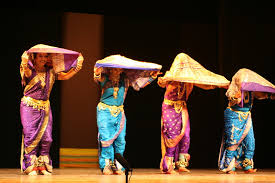
Fun Fact:
Lavani once served as a medium of social awareness in rural Maharashtra during the 18th century.
6. Kalbelia – The Snake Dance of Rajasthan
Performed by the Kalbelia tribe traditional snake charmers this dance is hypnotic.
Women in black swirling skirts mimic the movement of serpents while men accompany with instruments like poongi and dholak. The fluid body movements, the quick spins, and the mysterious vibe make Kalbelia a visual poetry.
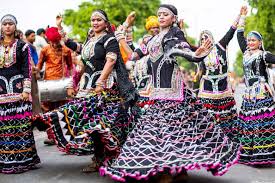
No, there are no actual snakes. But the dancer’s movement will make you believe otherwise.
Cultural Relevance:
UNESCO even recognized Kalbelia as an Intangible Cultural Heritage of Humanity. That’s how rare and treasured it is.
7. Chhau – Martial Art Meets Storytelling (Odisha, Jharkhand, Bengal)
A dance that merges martial arts, folklore, and classical expressions, Chhau is unlike any other.
Dancers wear elaborate masks and costumes to enact stories from the Ramayana and Mahabharata, with movements inspired by war strategies, animals, and nature.
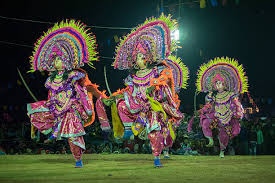
The masked warrior dancers of Chhau can leap like lions, twist like serpents, and strike like thunder all in a single performance.
Why Chhau Deserves Your Attention:
It’s where dance meets drama, and tradition meets adrenaline.
8. Yakshagana – Karnataka’s Theatrical Wonder
Imagine an all night performance that combines dance, music, storytelling, and elaborate costumes and you get Yakshagana.
This form of folk theatre often unfolds entire mythological sagas, with larger than life characters, dramatic makeup, and dialogues. It’s dramatic, musical, and utterly unforgettable.
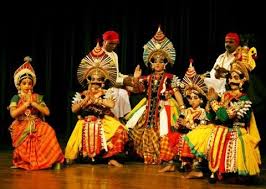
It’s not just a dance, it’s an experience of gods, demons, love, war, and morals. And it all happens under the open sky.
Pro Tip:
If you’re in coastal Karnataka between November and May, don’t miss a live Yakshagana. It’s a spiritual trip.
9. Dandiya Raas – Dance of Swords Turned Festive Beats
Originally a war dance performed with swords by the warriors of Gujarat, Dandiya Raas evolved into a festive dance with wooden sticks. Usually performed alongside Garba during Navratri, it’s a game of rhythm and coordination.
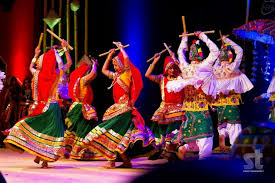
When hundreds of dancers tap sticks in unison, it feels like heartbeat of a community echoing through the night.
Behind the Beats:
Each strike symbolizes a clash between good and evil, rooted in mythology.
10. Karma Dance – Tribal Pulse of Central India
Performed by tribal communities like the Gonds and Oraons in Chhattisgarh and Jharkhand, Karma is raw, earthy, and deeply spiritual.
Men and women form circles under the open sky, singing about nature, life, and Karma Devta the deity of fate and action.
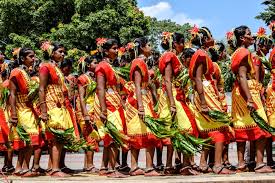
There are no fancy costumes. No commercial appeal. Just voices, drumbeats, and a primal connection to the earth.
Why It’s Unique:
It reflects the soul of tribal India, untouched and unfiltered.
11. Kathak – The North’s Dance of Stories
Before the Mughal durbars and Bollywood glamour, there were Kathakars, the storytellers.
Kathak comes from the Sanskrit word katha, meaning story. It evolved in the temples of Northern India, where dancers narrated tales of Krishna and Radha through graceful hand gestures (mudras) and expressive eyes.
Over time, Kathak absorbed Persian and Mughal influences, leading to its dramatic footwork, ghungroos (ankle bells), and courtly elegance.
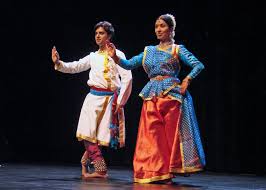
Watch a Kathak dancer spin perfectly balanced, with dozens of chakkars in one breath and you’ll realize, gravity is just a suggestion.
Why It Captivates:
Kathak is poetry in motion. It blends narrative, rhythm, and emotion like no other. Whether it’s love, loss, devotion, or celebration Kathak can express it all.
12. Bharatanatyam – Devotion on the Southern Stage (Tamil Nadu)
Perhaps the oldest classical dance form in India, Bharatanatyam has temple roots dating back over 2,000 years. Originally performed by temple dancers (devadasis) as a form of offering to deities, it’s a powerful blend of grace, geometry, and storytelling.
With strong footwork, sculptural poses, and intense expressions (abhinaya), Bharatanatyam is like watching ancient stone carvings come to life.
Every tilt of the head, every flick of the eye, every toe movement in Bharatanatyam means something. Nothing is random. It’s a language in itself.
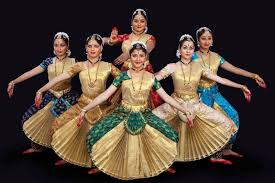
Deeper Insight:
Bharatanatyam is spiritual storytelling. Most performances narrate tales of Shiva, Vishnu, or Krishna through beautifully layered expressions.
13. Kathakali – Kerala’s Dance Drama Extravaganza
Ever seen dancers with elaborate face paint, massive headgear, and wide, hypnotic eyes performing tales of epic battles and gods? That’s Kathakali.
Originating in Kerala, Kathakali is a theatrical form where dancers don’t speak their expressions, movements, and dramatic makeup do all the talking. Each performance can last for hours and depicts stories from the Ramayana, Mahabharata, and Puranas.
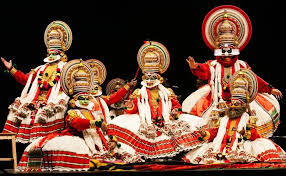
The eye movements alone in Kathakali take years to master. Yes, years. That’s how detailed this form is.
Cultural Gem:
Kathakali artists go through rigorous training and even oil massages to enhance flexibility and strength. This isn’t just dance it’s physical theatre at its finest.
14. Mohiniyattam – The Enchantress of Kerala
While Kathakali is loud, bold, and masculine, Mohiniyattam is its soft, feminine counterpart.
This dance form is inspired by Mohini, the female avatar of Lord Vishnu. It’s all about grace, fluidity, and subtle expressions. The dancer, clad in white and gold, moves like a gentle breeze through the room, narrating tales of love, separation, and devotion.
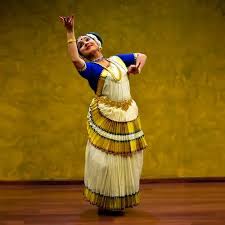
Watching Mohiniyattam feels like listening to a lullaby in motion every sway and curve touches something deep in your soul.
Why It’s Special:
The dance beautifully merges Lasya (grace) and Bhava (emotion), making it one of the most emotionally engaging classical forms of South India.
15. Kuchipudi – Andhra’s Dancing Drama
Originating from the Kuchipudi village of Andhra Pradesh, this form is a mix of dance, drama, and devotion. Earlier performed by male Brahmin dancers as religious drama on open air stages, it evolved into a refined form embraced by women too.
Known for its brisk footwork, graceful movements, and storytelling style, Kuchipudi performances often include dialogues, songs, and even dancing on brass plates.
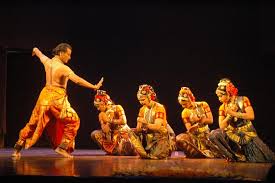
Yes, you read that right. Some performers dance on the rim of a brass plate while balancing a pot on their head. That’s Kuchipudi’s showmanship.
Why It Deserves a Spotlight:
It brings together music, speech, facial expressions, and movement in a seamless performance. It’s like attending a full theatre act but in dance.
Indian Folk and Classical Dances Final Verdict: India Dances in a Million Ways
Be it the tribal circles of Karma, the explosive energy of Bhangra, or the soulful curves of Mohiniyattam, Indian dance isn’t just about movement, it’s about memory, identity, and community.
These dances aren’t fading away. They’re thriving from rural villages to global stages, from community halls to international dance academies.
But here’s the truth: No YouTube video or Instagram reel can capture the feeling of witnessing these performances live.
So next time you’re traveling through India don’t just look for monuments or beaches. Find the nearest folk or cultural festival. Watch a live performance. Feel the rhythm. And maybe, just maybe, join in.
Updated FAQs on Indian Folk and Classical Dances
Q1. Are classical dances like Bharatanatyam and Kathak also folk forms?
Technically, they’re classical. But their origins are deeply rooted in temple and rural storytelling traditions, making them cultural cousins of folk dances.
Q2. How can I watch these dances live as a tourist?
Look out for regional festivals, temple fairs, or government sponsored cultural shows (like Surajkund Mela, Kala Ghoda Festival, Natyanjali Festival).
Q3. Can children learn Indian folk or classical dances?
Absolutely. Most dance schools offer training in both folk and classical forms. It’s a great way to connect with Indian heritage from a young age.
Q4. Do folk dances have fixed steps like classical dances?
Not always. Folk dances are often free flowing, community based, and spontaneous, whereas classical dances follow structured mudras and grammar.
Q5. Where can I explore these dances digitally?
Try platforms like Doordarshan archives, Sangeet Natak Akademi, or regional YouTube channels promoting cultural heritage.
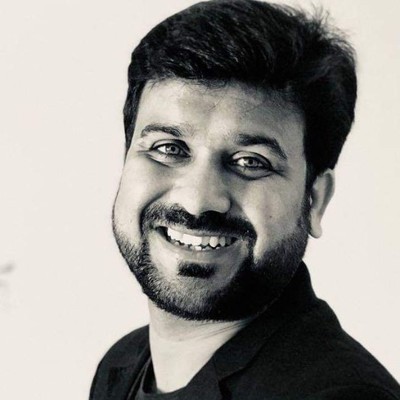
Hi, I’m Prashant Jain — a curious soul, storyteller, and content creator at heart.I’ve always been drawn to the world of entertainment, travel, sports, health & lifestyle — not just as a writer, but as someone who genuinely lives these experiences. Whether I’m binge-watching the latest OTT series, exploring offbeat spiritual destinations in India, or diving deep into wellness routines and cricket match insights, I love sharing what I discover with like-minded readers.
PopNewsBlend is my way of blending personal journeys with meaningful stories — ones that inform, inspire, and keep you ahead of the curve. Everything I write comes from real observations, hands-on experiences, and a deep passion for understanding the world around us.
Discover more from Popnewsblend
Subscribe to get the latest posts sent to your email.

